Thunderbolt on Windows Part 2: Intel's DZ77RE-K75 & ASUS' P8Z77-V Premium
by Anand Lal Shimpi on June 3, 2012 2:08 AM EST- Posted in
- Motherboards
- CPUs
- Intel
- Asus
- Thunderbolt
- Ivy Bridge
- Chipsets
Quad-core mobile Sandy Bridge, 2.5" SSDs and Thunderbolt together have allowed me to use a notebook as my primary work machine. I get all of the portability benefits of a notebook, but with almost none of the performance sacrifices. The only thing I'm really missing is a good, external discrete GPU solution but that's a problem being worked on either via Thunderbolt link aggregation or the second revision of the Thunderbolt spec.

Despite what it's done for me, Thunderbolt has to be one of the most strangely handled interface specs of recent history. Intel engineered the spec, but Apple helped with a lot of the connector and cable design and as a result received a year long exclusive on Thunderbolt. Since its introduction, Thunderbolt has received a reasonable amount of support on the Mac platform. Apple even builds a display designed exclusively for use with Thunderbolt equipped Macs. Companies like Promise, Seagate, Western Digital, LaCie and Elgato are all shipping Mac compatible Thunderbolt devices as well.
With the exclusivity agreement over, Intel's partners in the Windows PC space are allowed to ship Thunderbolt enabled motherboards and systems. Making things even more bizarre is the fact that all Thunderbolt devices have to go through Intel's certification program if they are to be approved for use under Windows. Technically only Promise's Pegasus is certified (or about to be certified) for use under Windows, despite the fact that all of these Thunderbolt devices have been available for use under Windows via Boot Camp on Macs.
The complications extend even further when you realize that Apple's own products aren't certified for use under Windows. The Thunderbolt Display is only officially supported under OS X and I don't see Apple being incredibly motivated to work on Windows certification for it. Interfaces like USB are great because you can generally count on anything that physically fits in the port just working. With Thunderbolt on Windows we now have a situation where you can't assume the same.
We got the first look at a Thunderbolt equipped PC motherboard with MSI's Z77A-GD80 a couple of weeks ago. The interface worked but was not without its quirks. To be totally fair however, the Thunderbolt experience under OS X isn't perfectly problem free either. It turns out that MSI sampled that motherboard prior to making it through the motherboard certification process. Since then, the motherboard has made it through cert and has an updated BIOS that should improve its behavior.
Both Intel and ASUS sent us their latest, fully certified, Thunderbolt equipped motherboards for another look at how the interface works under Windows. With motherboards available today, it's now time to take a complete look at what Thunderbolt is like outside of the Apple ecosystem.
The Motherboards
ASUS sent its P8Z77-V Premium motherboard with Thunderbolt support, while Intel sent its DZ77RE-75K Thunderbolt board. Only the ASUS board is publicly available and is priced at $450. ASUS will have a more affordable SKU with integrated Thunderbolt available in the future: the P8Z77-V Pro/Thunderbolt, which should be priced below $300. Other ASUS boards will be upgradeable to support Thunderbolt via an on-board header + add-in card.
The Intel board starts at $262 and goes as high as $278 depending on the in-box configuration (both include WiFi/BT dongles, while the $278 version comes with front panel USB 3.0 support).
Both boards branch the Thunderbolt controller off of the Z77 PCH, borrowing four PCIe 2.0 x1 lanes. Given how full featured these motherboards are, PCIe switches are employed to allow the use of all the remaining PCIe devices connected to the PCH.
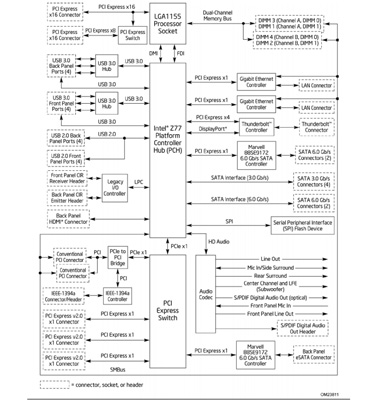
Intel's Z77 Thunderbolt Motherboard Block Diagram
ASUS goes one step further and includes a PCIe 3.0 switch to enable quad-CF/SLI support despite the limited number (16) of PCIe lanes Intel's LGA-1155 CPUs provide. ASUS' board features all the bells and whistles including a 32GB Marvell based Liteon mSATA SSD:
The Thunderbolt port on both boards can serve as either a Thunderbolt port or a DisplayPort output, similar to the behavior on a Thunderbolt Mac. Discrete GPUs are supported through the on-board Thunderbolt/DisplayPort output, provided you have Lucid's Virtu software installed.
As Thunderbolt carries more bandwidth than USB 3.0, trace routing is very important to achieving max performance. You'll notice that on all Thunderbolt boards we've tested thus far, the Cactus Ridge controller and Thunderbolt port are very close to one another. The spec for max trace length between the Thunderbolt controller and port is two inches, compared to up to 10 inches for Intel's USB 3.0 controller.
ASUS tells us that in order to reduce crosstalk it spaced Thunderbolt traces 1.5x wider than traces for USB 3.0 on its boards. Finally, all Thunderbolt traces are on the same PCB layer and don't feature any sharp angles in their route—only gradual arcs, which further improves performance. There's an impressive amount of engineering that has to go into bringing Thunderbolt support to a motherboard.
BIOS/UEFI support for Thunderbolt appears to be identical across all of the third party board makers. ASUS' Thunderbolt options look identical to MSI's for example:
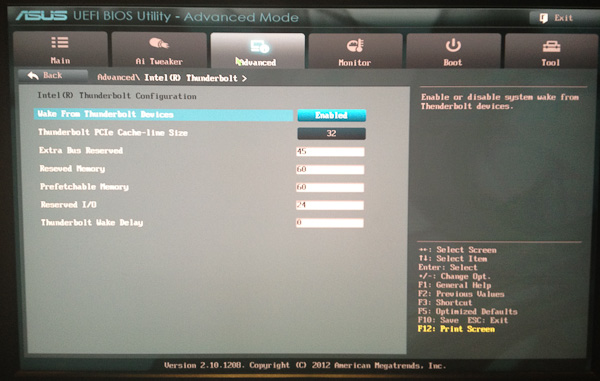
Interestingly enough, Intel doesn't actually expose any of the specific Thunderbolt settings. The Intel board just lets you enable/disable the interface itself:
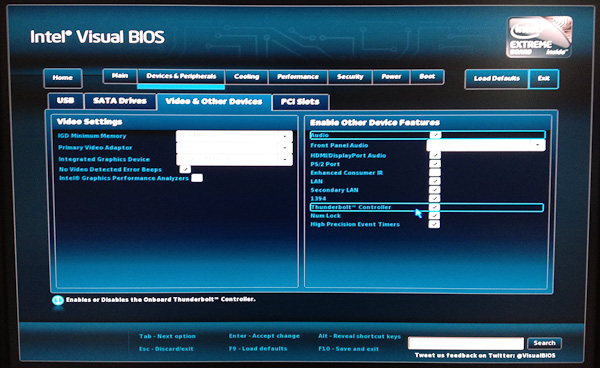


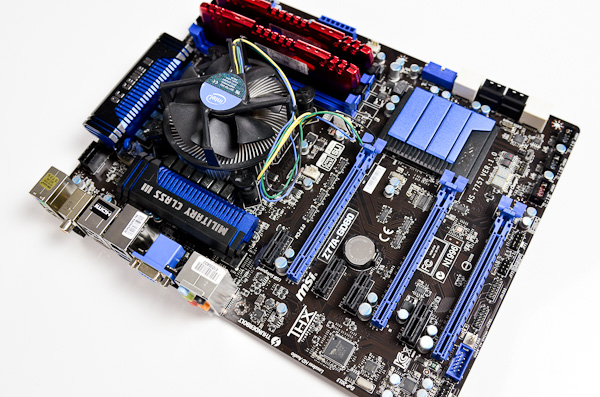
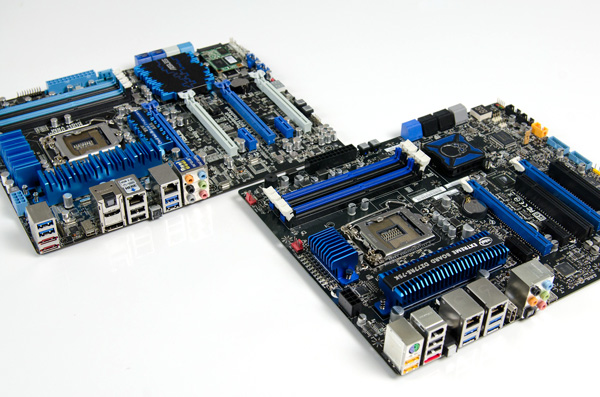

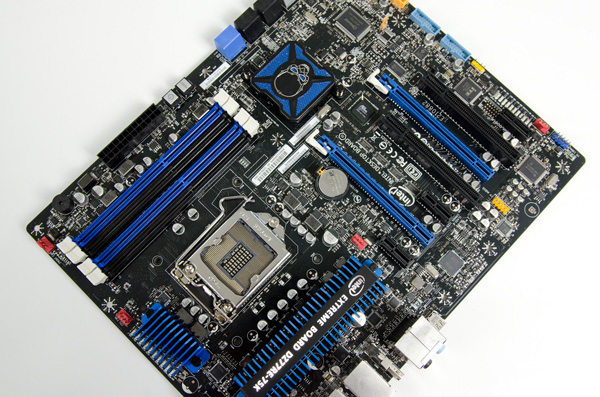
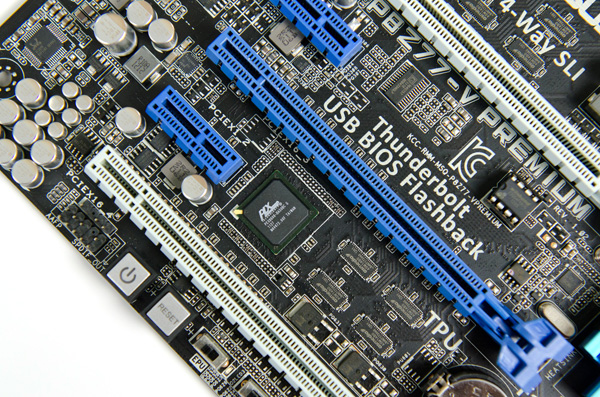
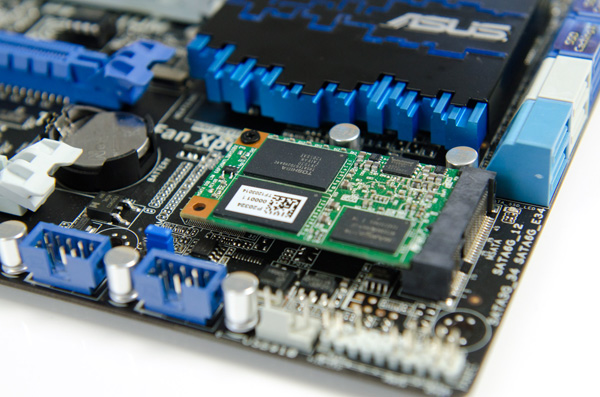
















116 Comments
View All Comments
S3anister - Friday, June 8, 2012 - link
Most people have trouble making out text, yes. However, the problem does not lie with a high resolution. It's the fault of OS developers and website developers not coding for anything other than these low-res displays.S3anister - Friday, June 8, 2012 - link
You're the kind of person that said "Oh we don't need SATA my IDE drives are perfectly fine."Imagine how sweet it would be to rock a SSD on a retro IDE interface! Full-on 133, baby. Serious bandwidth.
MobiusStrip - Thursday, June 14, 2012 - link
HDMI was designed for raster-based displays. Yep, CRTs.WTF is the matter with people cheerleading AGAINST better technology?
USB is wholly unsuited to the demands of high-throughput applications like external storage and video, but you still see noobs trying to pit it against Thunderbolt. It's like they learned nothing from Firewire.
ananduser - Monday, June 4, 2012 - link
Apple "pushing" what? Apple didn't push anything, absolutely anything related to TB. Every other OEM would've have the TB interface built in from the start if Intel treated TB like USB, and that is in indiscriminate fashion. OEMs didn't built it in because they were NOT ALLOWED to do so not because it was an impediment. Apple having TB built in has nothing to do with propagating TB and has everything to do with Apple getting its marketing dollars' worth out of TB and bang the "exclusivity" factor of their macs.No sooner than you cross over the pond(if you're US) mac awareness plummets. What about TB awareness ? There is no such thing.
repoman27 - Monday, June 4, 2012 - link
Apple pushed a pile of cash in Intel's direction. They agreed to buy 20 million Thunderbolt controllers in the first 12 months that Intel was shipping them in exchange for exclusivity. I'd wager that cost them more than a quarter billion dollars for the privilege.This also ensured that 5% of PCs shipped globally included Thunderbolt in its first year of existence. I doubt any other OEM would have made that kind of gamble on a nascent technology such as Thunderbolt. I also doubt that Intel could have produced substantially more Thunderbolt controllers than they already did in 2011.
CeriseCogburn - Monday, June 4, 2012 - link
A bunch of head and pocketbook in the clouds nerds can have their neck beard tickled fancy while they do their elite e dance. It's wonderful. They can look toward the sky while they drool out how dreamy the new tech is.CeriseCogburn - Tuesday, June 5, 2012 - link
APPL didn't push it along it hogged it for itself for a whole year so it's insane fanboy base could go goggle eyed and stupid with exclusive world wide only ME handling.Duh.
MobiusStrip - Thursday, June 14, 2012 - link
"Firewire found its niche in high end A/V equipment."And this kind of comment is bogus. High end? Firewire was REQUIRED on pretty much every CONSUMER video camera from the mid-90s well into the '00s. Firewire was the only way to get video off a DV camera.
ggathagan - Sunday, June 3, 2012 - link
TB *IS* superior to USB3.If nothing else, compare USB3's bandwidth of 5 Gbps to TB's bandwidth of 20 Gbps in each direction.
That said, I think many misunderstand ThunderBolt.
It's not a device in-and-of-itself, it's a flexible I/O bus mechanism that's fairly protocol-independent.
So you can use it for FW400/800, USB 3, DP, or Ethernet.
Given that the one-year agreement just ended and PC motherboard are just now beginning to implement TB, your portent of doom is a little premature.
As with any new technology, prices drop as the technology develops and is adopted.
Intel started shipping the 2nd gen TB controllers in April and the design of the Cactus Ridge controller reduces the cost of implementing TB compared to the 1st gen.
Alexvrb - Sunday, June 3, 2012 - link
Yeah except it's an entirely proprietary interface, controlled solely by Intel, and they gave Apple an entire year of exclusivity. I'll be avoiding Thunderbolt like the plague.